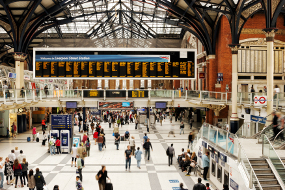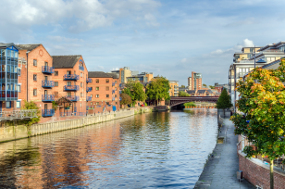
More than 1,000 travel companies trust us to sell their tickets all in one place.
The Best Train Stations in the UK
For many people in the UK, the most efficient and comfortable way to travel is by train. Be it travelling to and from work, going to see loved ones or going on a weekend getaway, millions of people opt to travel by train. For those who are more environmentally concerned, travelling by train can offer a more sustainable way to travel, whilst also providing great flexibility in regards to travel dates and luggage.
There is, however, much that can go wrong when taking a train. Many of us have been in a situation where we have missed a connecting train or been delayed. With that in mind, we decided to examine which train stations in the UK are the best and most passenger-friendly. To complete the study, we evaluated 30 of the most popular train stations in the UK in a quantitative study. Read the table below to see the top 30 train stations.
Edinburgh Waverley emerged as the best train station in the UK in the study due to its central location, convenience and punctuality. Every year, the train station offers millions of travellers many amenities, including public transport connections, wheelchair access and public toilets. Additionally, 78 percent of trains arrive on time. The train station with the highest number of punctual trains is Stansted Airport, with 90 percent of trains arriving on time.
The UK’s largest train station comes in 9th place in the study, with a final score of 64, offering passengers 78 shops and 276 restaurants nearby and amenities such as free public wifi and lockers. The UK’s international station that offers direct trains to many cities in Europe, London St Pancras International comes in 22nd place with an impressive 75 percent of trains being on time, it seems the international trains are not a hindrance towards punctuality.
How Omio compiled the ranking
To create the ranking, the 30 most popular train destinations (after bookings via Omio between May 1, 2020 and
February 15, 2021) in the UK. Four categories were examined, looking at what makes a train journey more comfortable
and pleasant. Train delays are one of the greatest stress factors when travelling by train, so we included data that
shows how many of the trains leave on time. The amenities of the train station also play an important role in making
a train journey comfortable. The study provides data on amenities such as parking spaces, parking spaces for
bicycles, connections to local transport, wheelchair access, lockers, public toilets, car rental services, free WiFi
and a first-class lounge.
Additionally, we also had a close look at the number of shops, restaurants and pharmacies within a radius of half a
mile from the train station. Using such facilities is a great way to pass the time, especially with longer transfer
times. The last criterion we were interested in was the location of the train stations. The more centrally located a
train station is from the city centre, the easier it is for visitors and locals to reach it. All information on the
methodology of the study can be found here.
Train Stations in the UK
In the UK, there is a vast network of Railway lines and stations; a total of 2,520. In general, train stations in the UK are a central point of local public transport. Thus, these often form a focal point in the everyday lives of people. For this reason, many are large, category listed buildings, which often dominates the skyline and offers a point of recognition in the city or town.
London is the hub of the UK's extensive rail network, and according to reports from the Office of Rail Regulation, London’s Waterloo, Victoria, Liverpool Street, London Bridge, Charing Cross, Euston and Paddington stations are the busiest in the country. Three other major train stations in the UK outside the capital are Birmingham New Street, Glasgow Central and Manchester Piccadilly, which each served some 30 million passengers between 2011 and 2012 and provide regular services to major cities all across the UK. The three stations ensure representative coverage of all areas of the UK; The Midlands, The North of England and Scotland.
London Waterloo | Glasgow Central | Manchester Piccadilly
Major Train Stations in The UK
London Waterloo
he UK's largest train station, Waterloo, comes in 13th place in the study, with a final score of 46.4. London Waterloo is a popular commuter station, with the vast majority of passengers arriving here on local or suburban services. These regional trains are mostly operated by South West Trains, who provide services to South West London, Surrey, Hampshire, Dorset and Berkshire; provided by Southwest trains. Connected to the main station is the underground stop, Waterloo; this is on the Jubilee, Bakerloo, Northern and Water & City.
Popular Connections from London Waterloo
Glasgow Central
Along with Edinburgh Waverley, Glasgow Central is the main station connecting Scotland with numerous English cities, providing frequent services to London Euston, Manchester Piccadilly and Birmingham New Street. The building itself is a Category A listed building, located in the centre of the city, just a short walk east of Prices Square shopping centre.
Popular Connections from Glasgow Central
Manchester Piccadilly
Manchester Piccadilly is the busiest station of the four main stations in Manchester and is a major travel hub in the UK connecting the northern city with direct services to London Euston, Cardiff and Sheffield. The main providers that operate from this station include CrossCountry, Northern Rail, Virgin Trains, First Transpennine Express and Arriva Trains Wales.
Popular Connections from Manchester Piccadilly
The Biggest Train Stations by Passenger Numbers in the UK
| Station | Annual Passengers (Millions) | No. of Platforms |
|---|---|---|
| London Waterloo | 98.5 | 22 |
| London Victoria | 81.9 | 19 |
| London Liverpool Street | 63 | 18 |
| London Bridge | 56.4 | 15 |
| London Euston | 40.4 | 18 |
| London Charing Cross | 40.1 | 6 |
| London Paddington | 35 | 14 |
| Birmingham New Street | 34.7 | 13 |
| London Kings Cross | 29.8 | 12 |
| Glasgow Central | 27.2 | 17 |
Train Station Categories in the UK
To classify the different train stations in the UK in terms of their size, use and importance, there are several categories. There are 6 categories, A-F, in total which were initially devised in 1996 and then revised in 2009 to the current arrangement. Of the 2,520 stations in the UK, many are will be found in more than one category
Category A train stations are the 28 stations that are considered national transport hubs in UK. In order to be classified in the top category the stations need to offer more than 2 million journeys a year.
Category B, of which there are 67, must also provide over 2 million trips annually; however, are merely regarded as a regional interchange.
A total of 248 stations are regarded as Category C12; these stations are known as important feeder stops and offer between 500,000 to 2 million trips.
Category D are medium staffed stations with between 250,000 and 500,000 trips per year; there are 298 stations with this classification in the UK.
Category E and F12 both offer under 250,000 journeys, on average, a year. The distinction between these categories is Category E stations have limited staff working there and F12 are unstaffed. Unstaffed stations have the largest number of stations with a total of 1,200 and Category E stations have almost half with just over 650.
Train Stations in Europe
All Train Stations
A
D
G
Gare de Marne la Vallée-Chessy
Genova Costa di Sestri Ponente
J
M
Mannheim ARENA/Maimarkt station
P
Paris Roissy Charles De Gaulle Airport
Petershausen (Oberbay) station
Pietrarsa-San Giorgio a Cremano
S
Sachsenhausen (Nordbahn) station
Santa Flavia-Solunto-Porticello
Steinfurt-Burgsteinfurt station
Stuttgart Neuwirtshaus station
Stuttgart-Bad Cannstatt station
V
Villagarcía de Arosa (station)
Y
B
Bad Wildbad Uhlandplatz Sommerbergbahn
Bahnhof Hersbruck (rechts Pegnitz)
Bahnhof Schwarzenberg (Erzgeb)
Bilbao-Abando Indalecio Prieto
E
Endingen am Kaiserstuhl station
H
K
København, Københavns Lufthavn
N
Niederdorf-Prags/Villabassa-Braies-Val di Braies
Q
T
W
Z
C
Capo d'Orlando-Naso rail station
Centola-Palinuro-Marina di Camerota
F
Ferrandina-Pomarico-Miglionico
Fiumicino Airport Railway Station
Frankfurt am Main Flughafen Fernbahnhof
I
L
Lauterbach (Hess) Nord station
Limburgerhof Bahnhof (Südseite)
Lutherstadt Wittenberg Hauptbahnhof
O
Oulx-Cesana-Claviere-Sestriere

















